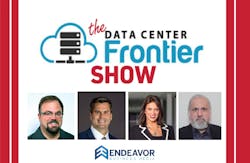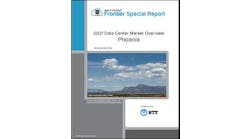DCF Show: Data Center Construction and Dallas Market Talk with Burns & McDonnell
For this episode of the DCF Show podcast, Data Center Frontier's Editor in Chief Matt Vincent and Senior Editor David Chernicoff speak with Burns & McDonnell's Robert Bonar, PE, LEED AP, Vice President, Mission Critical Facilities, and Christine Wood, Vice President leading the firm's Dallas-Fort Worth Global Facilities practice.
Burns & McDonnell is a provider of engineering, architecture, construction, environmental and consulting solutions, who as part of its mission-critical and data center practice is brought in to help plan, design, permit, construct and manage client projects in the space.
Bonar and Wood begin the podcast by providing an overview of the company and their roles there, along with their backgrounds in the industry. An overarching theme of the discussion is how a client's selection of a data center and mission critical consultant is based on more than just an ability to meet service needs.
The discussion also covers current data center industry construction trends, especially in the areas of siting and power, while probing the similiarities and differences in planning data center builds for enterprise, colocation and hyperscale clients.
Dallas-Fort Worth Data Center Market Focus
Cushman & Wakefield’s 2023 Dallas-Fort Worth Data Center Report stated that the Dallas-Fort Worth data center markets saw record absorption of 386 Megawatts in 2023 -- a nearly 7x increase since 2020 -- driven by exponential growth in demand for cloud computing and AI/machine learning applications.
Cushman & Wakefield further reported the Dallas-Fort Worth market's vacancy to be at an all-time low of 3.73% last year, with colocation rents and data center land prices there continuing to rise. The commercial real estate services company added:
"Despite a robust construction pipeline – 1.4 million square feet that can provide 225 MW – the vast majority of the market’s new data center supply for 2024 and 2025 has been pre-leased. Cloud providers securing large campuses through pre-leasing and AI/ML companies leasing the market’s few remaining pockets of available space are the primary drivers of DFW’s record demand."
DCF asked Wood and Bonar about the D-FW data center market and Burns & McDonnell's role in it, including the firm's background and present developments there, as well as the location's future roadmap regarding power, interconnectivity, workforce factors.
Here's a timeline of key discussion points on the podcast:
2:27 - After introductions and table-setting, the Burns & McDonnell experts emphasize the importance of looking at data center client needs holistically and getting ahead of what they need for a given project.
4:53 - Discussion turns to the impact of generative AI on the data center industry and the uptick in demand for first-of-a-kind designs.
8:44 - Further exploration of how the rapid pace of change in the data center industry has bred increased demand in the market for qualities such as speed-to-market and first-of-a-kind design.
9:22 - DCF inquires about planning for different types of data center builds, and the differences between enterprise, colocation, and hyperscale developments, as well as the impact of AI support, are explored.
14:34 - The discussion further illuminates challenges and changes in the data center industry, including the influence of AI technology on new designs and in future-proofing facilities.
15:04 - Burns & McDonell's Wood discusses the D-FW data center market, highlighting its growth potential due to its central location, low real estate costs, and robust power availability.
20:25 - To conclude, DCF's editors circle back to the topic of renewables and solar consulting in relation to data centers, leading to a discussion on combining solar with battery storage for future data center needs.
Here are links to some related DCF articles:
- The Current State of Power Constraints for New Data Center Construction
- Skybox Plans 300-Megawatt Campus South of Dallas
- Building Greener: Compass Seeks Sustainability in its Construction, Supply Chain
- Dallas Sees Record Data Center Leasing Activity in 2022
- The Big City Edge: Dallas is a Hotbed for Edge Computing
- Power Infrastructure and Tax Incentives Drive Dallas Data Center Market

Matt Vincent
A B2B technology journalist and editor with more than two decades of experience, Matt Vincent is Editor in Chief of Data Center Frontier.





